Latest News
Kitchen Chat and more…
Kitchen Chat and more…
Mars Whisky!
Mars is one of the oldest whisky companies in Japan. Even though Mars started distilling in 1960 in Yamanashi, the buying and selling of whiskies date back to 1949! For a whisky company with 2 distilleries (Shinshu Distillery and Tsunuki Distillery ) and 3 maturation sites, it could be confusing sometimes! So with the help of Hombo Shuzo and Barworks, here’s a guide!
Note: The names of various locations are in colour because it can indicate which distillery or ageing site it is from, similar to Uigeadail or Inchmoan.
The distillery is in Miyadamura, Nagano prefecture at the foot of Mt. Kiso Komagatake. Shinshu distillery started making whisky in 1985 and was mothballed from 1992 to 2011. Mars whisky uses both peated and unpeated concerto barley from CRISP maltings in the UK, with 4 different peating levels at 0ppm, 3.5 ppm, 20ppm and 50ppm. After milling the barley, the grist goes into a stainless-steel 8000L lauter mashtun, along with a stream of hot water to extract barley sugar. The sugary and clear liquid that the mashtun extracts is called the wort. The wort is cooled down and subsequently enters a 7000L washback with a combination of distiller’s yeast, ale yeast and slant yeast.
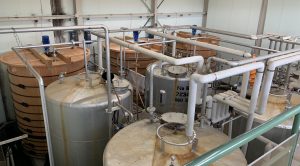
Washbacks in Shinshu Distillery. Photo courtesy of Hombo Shuzo Co. Mars Whisky.
In before 2016, the fermentation period was 3 days long, however, this fermentation period was increased to 4 days, so as to allow more flavours to develop. Shinshu has 5 cast iron washbacks and newer 3 Douglas fir wooden washbacks. After fermentation, this strong beer called wash at 7-8% alcohol by volume (abv) goes into a 6000L wash still for distillation. Both distilleries use indirect heating for their stills as it is energy efficient. The distillate is called low wines with an abv of 21-22% and is cooled in a shell & tube condenser before going into an 8000L spirit still for the second distillation.
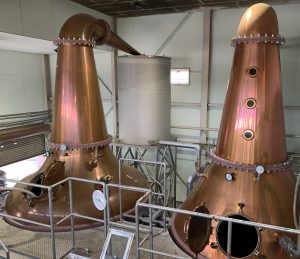
The Pot Stills of Shinshu Distillery. Photo courtesy of Hombo Shuzo Co. Mars Whisky.
This distillate goes through a worm tub, which will contribute to the robustness of the spirit character! The new make strength is around 70% and diluted to 60% before filling.
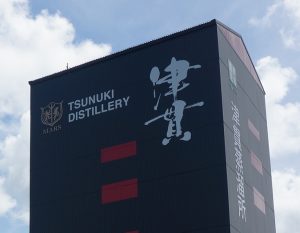
Tsunuki Distillery. Photo courtesy of Hombo Shuzo Co. Mars Whisky.
Mars Whisky’s second distillery started in 2016 and lies on the southwest side of Kagoshima called Tsunuki. Similarly to its sister distillery, Tsunuki Distillery uses both peated and unpeated concerto barley from CRISP maltings. The milled barley goes into a slightly smaller 5000L lauter stainless steel mashtun with hot water to produce a clear wort. This wort goes to one of 5 wash stainless steel washbacks in the distillery. The same yeast varieties and fermentation times are utilised, therefore, Tsunuki Distillery produces wash with a similar abv as its sister distillery.
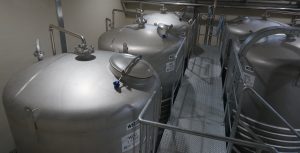
Washbacks at Tsunuki Distillery. Photo courtesy of Hombo Shuzo Co. Mars Whisky.
The distillation is somewhat similar to Shinshu distillery, except that both stills in Tsunuki Distillery use a worm tub condenser. The new-make spirit has the same abv range, and similarly, Mars whisky keeps the filling strength consistent at 60% abv.
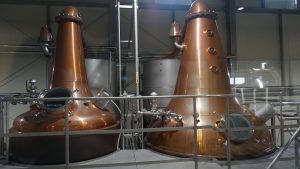
Pot Stills at Tsunuki Distillery. Photo courtesy of Hombo Shuzo Co. Mars Whisky.
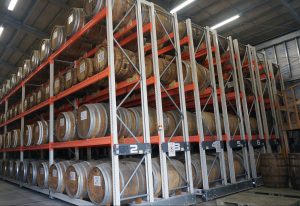
Racked Warehouse in Tsunuki Distillery. Photo courtesy of Hombo Shuzo Co. Mars Whisky.
There are three ageing sites, two of which are onsite at the distilleries and a third ageing site at Yakushima! Having three ageing sites would mean that there are three different climates for ageing Mars whisky. Climate affects the rate of maturation and therefore, the annual whisky loss per year, or angel’s share. One could easily compare these rates by looking at Scotch, Taiwanese and Indian whisky distilleries. With three slightly different rates of maturation, there are many more possibilities in flavours for Mars whisky. Humidity is also significant for estimating the drop in abv of the ageing whisky over time. A higher humidity would mean a slower loss of water than ethyl alcohol, which could lead to a faster decrease in abv, and vice versa.
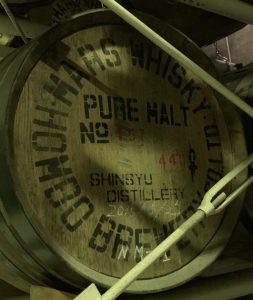
A cask ageing onsite at Shinshu Distillery. Photo courtesy of Hombo Shuzo Co. Mars Whisky.
The surrounding temperature ranges from a subzero -15°C in the winter to over 30°C degrees in the summer, and an annual average temperature is around 12 degrees. The at an elevation of 798m, the humidity around the distillery is 65-67% and has an angel’s share around 3-4%.
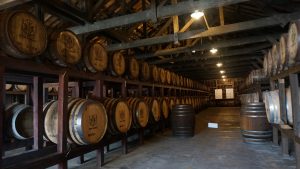
Rows of PX casks in the warehouse at Tsunuki Distillery. Photo courtesy of Hombo Shuzo Co. Mars Whisky.
Kagoshima has warmer climates with an annual average temperature of 18°C, with a temperature range of -2°C in the winter to a blistering 36°C degrees in the summer. The humidity is slightly higher than its sister distillery at around 70-72%, with a higher angel’s share at approximately 5-7%.
The Mars Yakushima Aging Cellar is on an island bearing the same name. Yakushima Island is a world natural heritage site and located southwest of Kagoshima and still almost three times as wide as Singapore though. This dunnage warehouse stands near the coastline, so the ageing casks breathes in the coastal air. The temperature on the island ranges from 5°C to 35°C in with an average annual temperature of 19°C. With a higher humidity at 74-76%, the angel’s share is higher as well, at 7-9%.
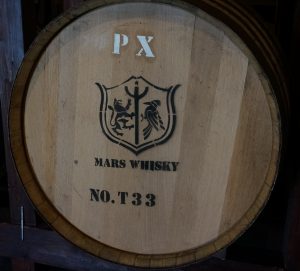
PX Cask. Photo courtesy of Hombo Shuzo Co. Mars Whisky.
The casks at Mars Whisky are used 4 to 6 times. The Yakushima Aging Cellar contains ex-bourbon casks and ex-sherry casks. The two onsite racked warehouses at the distilleries contain other unique and exciting casks resting away. Other than Madeira casks, Port casks, and French oak wine casks, there are Mizunara oak casks, umeshu white oak casks, shochu white oak casks and even sakura casks!
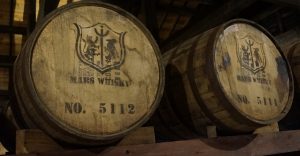
Ex-Bourbon Casks. Photo courtesy of Hombo Shuzo Co. Mars Whisky.
Hopefully, this article has shed light on the different variations of Mars whisky.
If you’re interested in getting yourself a bottle of Mars, you can head to Barworks. In addition, there’s also a 33% discount on the Annual Limited Edition 2019 bottling of Komagatake (from Shinshu Distillery) which you can get here!
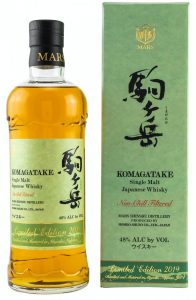
Mars Single Malt Komagatake Limited Edition 2019. Photo courtesy of Barworks.
Mars Single Malt Komagatake Limited Edition 2019
These are the tasting notes from the producers.
Nose: Ripe persimmon, apricot, and orange marmalade
Palate: Elegant and mellow taste like Chinese quince, melon and milk candy
Finish: Clean and comfortable aftertaste
Special thanks to Hombo Shuzo and Barworks, the official Mars whisky distributor in Singapore for the information and the photos!
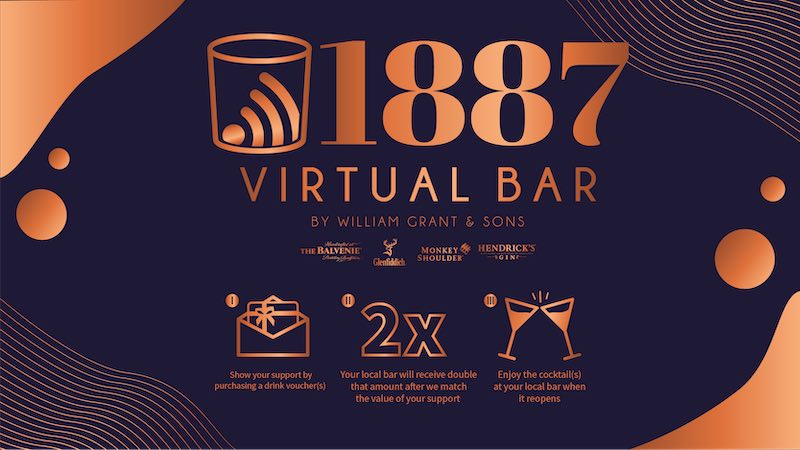
Credits: WGS Singapore
Life took an unexpected turn at the beginning of 2020, and our lives changed 360 degrees when Covid-19 surfaced and killed more than half a million people worldwide. Many of us have stopped work, or at least started working from home as countries move to curb the spread of the virus. Many lives were changed, especially those in the food and beverage industry. However, out of all that negative vibes, hope rises as people band together to create a new way to drink and socialise. A virtual bar, or a virtual tasting, is fast becoming the newest trend to hit the world as the alcohol industry strives to continue serving its customers through the next viable means.
William Grant & Sons, our friendly family-owned distiller, is no different. With the global situation getting worse, the company decided to do their part to help local bars to survive by opening a virtual bar to serve drinks, live from your home bar. The virtual bar is codenamed 1887 Virtual Bar to commemorate the year that WGS opened. The platform features weekly guest shifts hosting some of your favourite bartenders in Singapore together with brand ambassadors, Charmaine Thio and Brett Bayly of Hendrick’s Gin and Glenfiddich respectively.
The first session of the 1887 Virtual Bar started with Sam Wong, the head bartender at Shin Gi Tai, via Zoom on 9 April 2020. We logged in using the link given, and we found our hosts waiting for us. Charmaine Thio, brand ambassador of Hendrick’s Gin and Brett Bayly, brand ambassador of Glenfiddich, were already online together with the head bartender of Shin Gi Tai, Sam Wong. To kick start the session, Charmaine introduced 1887 Virtual Bar and what they hoped to achieve. She encouraged participants to ask questions via the chat function found in the Zoom sessions and to interact as much as possible through the limited functions available.
The virtual bar also sells cocktail vouchers, which participants can buy to support the bar. These vouchers can be redeemed at a later date at Shin Gi Tai when the Covid-19 situation in Singapore eases.
Sam Wong is a familiar face for many of us. For the first session, Sam created four different cocktails for the audience, based pretty much on what Shin Gi Tai is well-known for. Charmaine had the chance to request for the first cocktail (because ladies first!) and she asked for something light and refreshing. Sam took up the challenge easily, creating what he called, “The Dragon’s Daughter”.
You can check out the ingredient in the picture below.
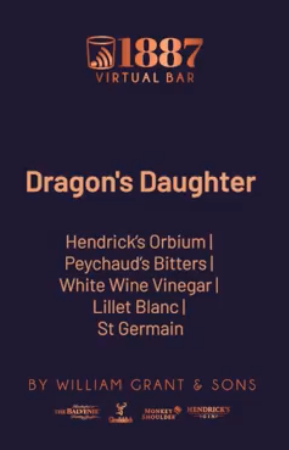
From the screen, it looked like an orange/pink drink and being a virtual session, not a lot of garnishes went into it. Nonetheless, it looked delicious, and I would highly recommend that you try this the next time you are at Shin Gi Tai!
After encountering the Dragon’s Daughter, Brett felt the need to have something solid to keep his nerves strong! So, he requested for a whisky-based cocktail. Sam, in response, created a cocktail that is not only whisky-based but also involved caffeine. Coffee so Stronk uses Nanyang infused coffee as part of its ingredients and it looked like a stiff drink! It is perfect after a hard day’s work.
Here are the ingredients.
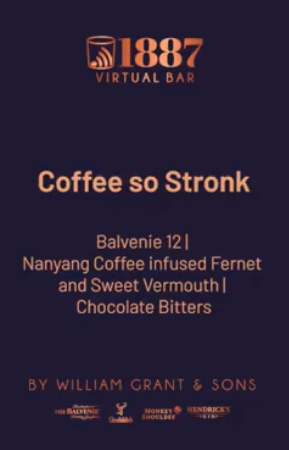
You may not have the Nanyang Coffee infused Fernet at home, and it is probably too troublesome for you to make it at home. So, head over to Shin Gi Tai after the Circuit Breaker eases off to have a taste of this cocktail!
Everyone loves a highball on a hot day! That was what Sam recommended after the first two cocktails. He said that the weather is terrible nowadays and a highball can help to bring down the temperature! After all, nobody wants to have a high temperature now too! Hahaha!
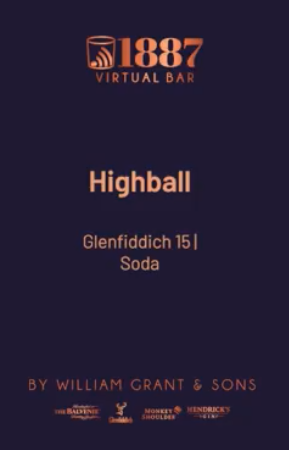
Yup, a highball is easy to make. As long as you have some whisky and soda, you can easily make your own highball! A note on Glenfiddich 15 years old though. This is one of the easiest whisky to drink and its sweet character makes it a great conversation starter. In case you are wondering, a highball is a Japanese concept of drinking whisky on a hot day. It is a simple mixing of whisky and soda (in the portion you want – most people do 30-70). You prepare a tall glass, put in ice, and you pour first the whisky into the glass, and then top the glass up with soda. Stir the mix with a spoon and you are done! If you want more flavours, add in a slice of lemon after squeezing some zest into it.
You may think that you wouldn’t want to order a highball in a bar, but trust me, it is really the best drink to have on a hot day!
Next up, Sam introduced Shin Gi Tai for those who have never been there. If you have never been there, you should try to go after the Circuit Breaker ends and bars reopen. Shin Gi Tai is a cosy, intimate bar in Telok Ayer with no menu! Yes, no menu! What the bar tries to achieve is to tailor a personalised service and cocktail for each patron. Tell the bartender what you fancy in terms of flavours, and watch them shake it up for you!
Shin Gi Tai, however, has its favourites. SGT Negroni is one of them. Made using only three ingredients, the Negroni is a classic favourite at the bar.
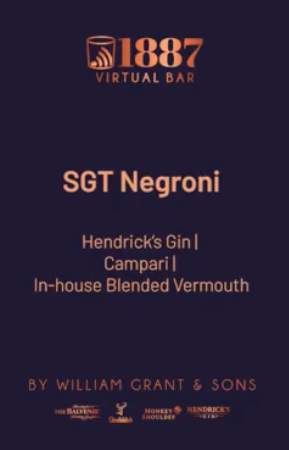
Sam showed us how simple it is to make the Negroni but I can assure you that I am not going to know how to make it so I am better off heading to Shin Gi Tai when the virus goes away!
The session concluded with a call for participants to ask questions. Sam took a few questions from the audience and he showed how experienced he is when someone asked for a low-calorie cocktail. I will not spoil the mystery here, so be sure to go to Shin Gi Tai to ask him! Finally, the hosts reminded everyone that we can support our bars through our kind purchases of vouchers to help them survive this tough period. Due to the time limit, the Zoom session ended with a final call to tune in again next week!
Well, it was a good session and I do encourage all of you to join in the next one (details below). However, I think the session could be more interactive. It would make the sessions more fun and resembles a real bar. Nonetheless, these are challenging times and we have to make do with what we have! Please support the 1887 Virtual bar and stir up your own cocktail at home!
You can find out more about the guest shifts and participating bars at the below link:
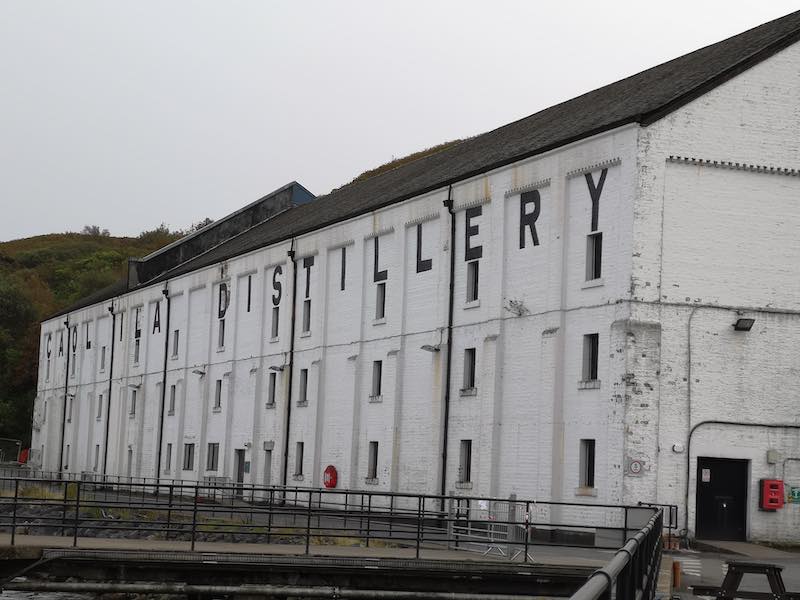
Caol Ila Distillery
Our visit to Caol Ila Distillery was the beginning of the end of our Islay trip. It was unfortunate that the distillery was undergoing renovations when we were there. It resulted in our tour getting cut, but the compensation we got was more of their gold nectar!
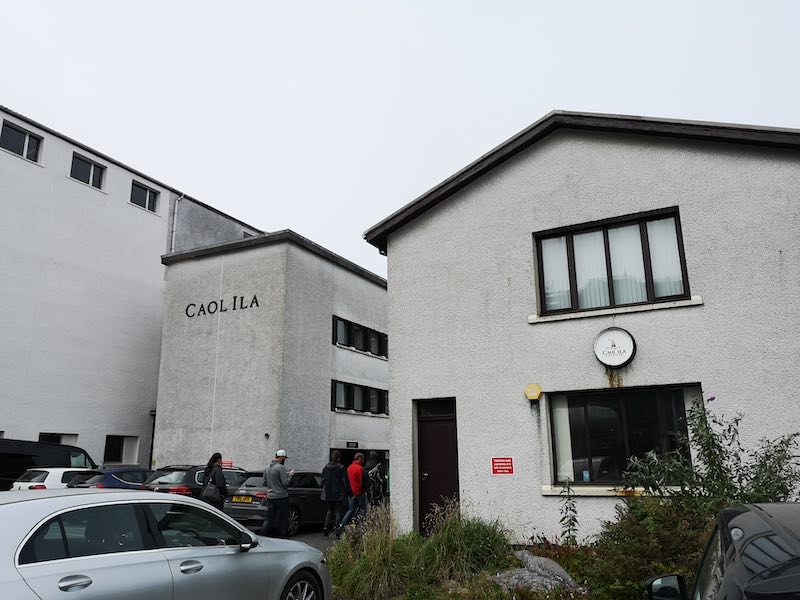
Walking to the Visitor Centre
Due to the renovations, our vehicle was not allowed to go right up to the gate, so we parked far away and walked up to the distillery. The safety measures put up at the distillery were impressive, so we felt safe during our time there, even with all the construction works all around.
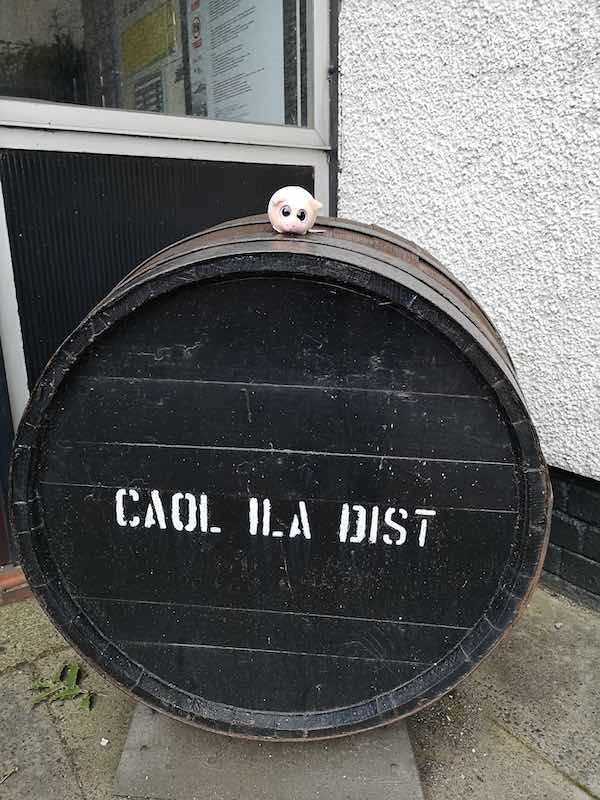
Curly the Pig reporting in
When we reached the visitor centre, the cask greeted us in a quiet corner. The cask served an important role though – it was the meeting point for all Caol Ila tours! Upon entering the little shop, we were quite shocked at the number of people squeezed into the tiny space. A group of Caol Ila fans turned up at the distillery without a prior tour booking, and they were unhappy that the team at the shop turned them away! There was a little commotion, but it was sorted out after one of the team checked the tour for the day after and managed to squeeze them in.
Our tour guide came to meet our group shortly after the commotion. She explained that as the renovation was on-going, we would not be able to visit the whole distillery but only the Still House, which was still untouched by the construction. We were quite disappointed, but there wasn’t anything we could do about it.
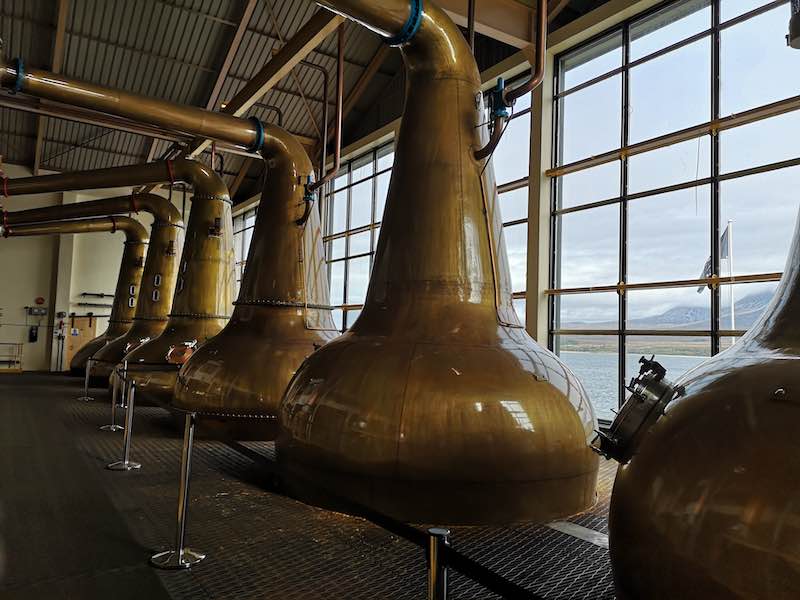
The Caol Ila Stills
Inside the Still House, our guide shared all the details of the production at Caol Ila Distillery with our group. We visited on a Sunday, and the stills were not running because the distillery only works Monday to Friday! It was surprising as most of the other distilleries work seven days a week, 365 days a year. Our group joked that it must be a good thing to be a production crew at Caol Ila! You get the weekend off!
Caol Ila smokes their barley to around 50ppm, and it should get a very smokey whisky like Ardbeg. However, their stills with the long lyne arms created a lot of reflux, and the result is a much softer smoke.
The wash still at Caol Ila has a capacity of 58 thousand litres, but they only charged 19 thousand litres of wash in each distillation cycle. The aim is to create high refluxes within the still and increase the purity of the distillate.
The distillery takes a cut of the heart between 75% to 65% abv of the distillate. Our guide shared that the process takes an average of 2.5 hours during a normal distillation cycle. The head is around 85%% abv while the tail is below 65% abv. The head and tail go back to the distillation cycle in the next charge, similar to most other distilleries.
The team then dilutes the new make to 63.5% abv (industry standards) before putting them into their respective casks for maturation. An interesting point to note is that Caol Ila does not mature their whisky on-site, but send them to mainland Scotland to mature in a separate warehouse.
Noticing that some unfinished casks were sitting around the distillery, one of us asked our guide if those casks were no longer in use. She said that while those that we saw were indeed staves that they discarded, Caol Ila builds their own casks. How they do it is to import bourbon staves from the United States of America, and their talented team build the casks up on their own, complete with their specification. Most of the casks are hogshead.
Our article title already suggested that Caol Ila is the main contributor for Johnnie Walker blends. Still, you may be shocked to discover that up to 85% of all Caol Ila whisky goes to Johnnie Walker! Before the boom of Caol Ila single malts, up to 95% of the whisky goes to the blends. Diageo reduced it to 85% in 2011.
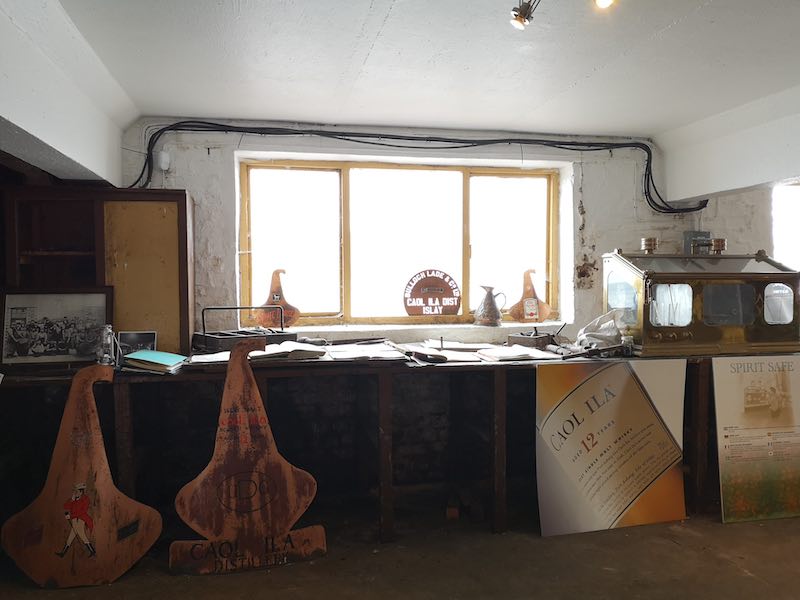
The Tasting Room
After the short but information session in the Still House, our group went to the Tasting Room, a large, upper room hidden by a wooden door! It overlooks the Sound of Islay and right opposite us, the Paps of Jura! Now you might remember that the Still Room in Ardnahoe overlooks the Paps as well, but we weren’t lucky during our trip to Ardnahoe to view them. However, we were lucky this time!
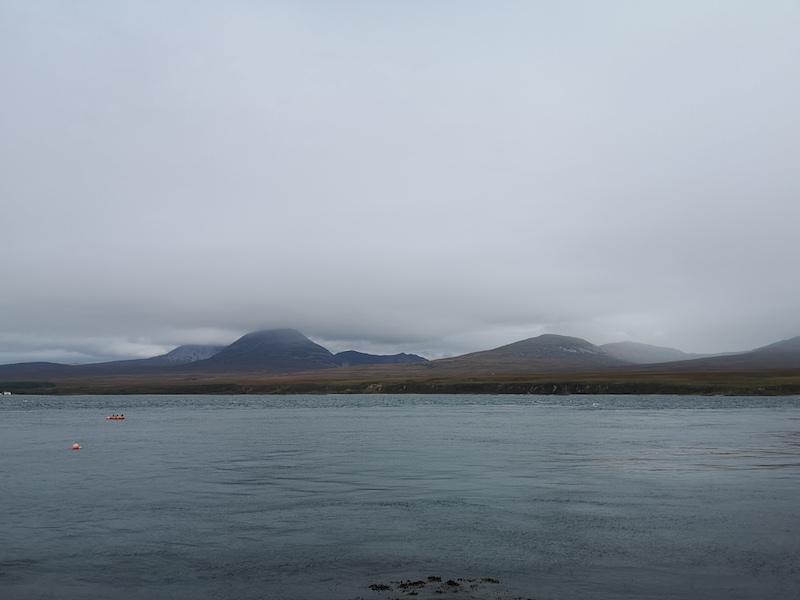
The magnificent Paps of Jura
Ta-da! This was the view right outside the window of the tasting room. Even though the clouds were still low, we could see the two peaks of the Paps, which were magnificent. Of course, our photograph couldn’t do justice to the beauty that we witnessed on Islay.
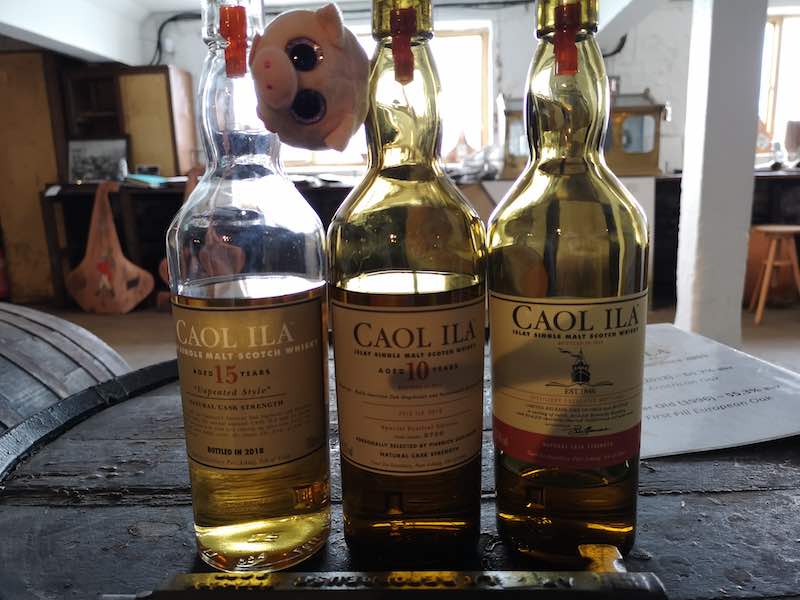
Caol Ila 15 YO Unpeated, Caol Ila 10, Distillery Exclusive
Our guide invited us to take our places at a large table where our drams awaited. First, we gave us each a branded Glencairn glass; then she began introducing the whiskies. The distillery upgraded our tour basically, to include two drams direct from the cask as a form of apology for the renovations. You should hear the mumble of appreciation all around the table!
The list of whisky was as followed:
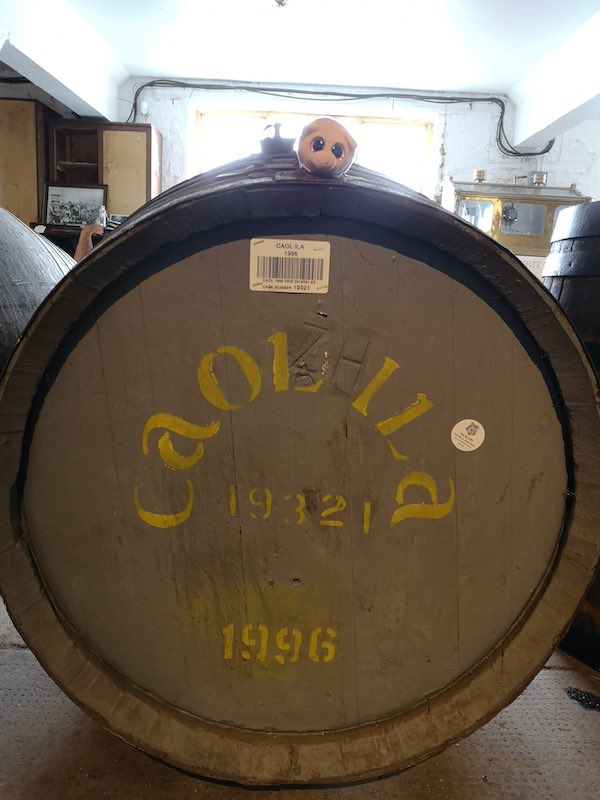
1996 Caol Ila Cask
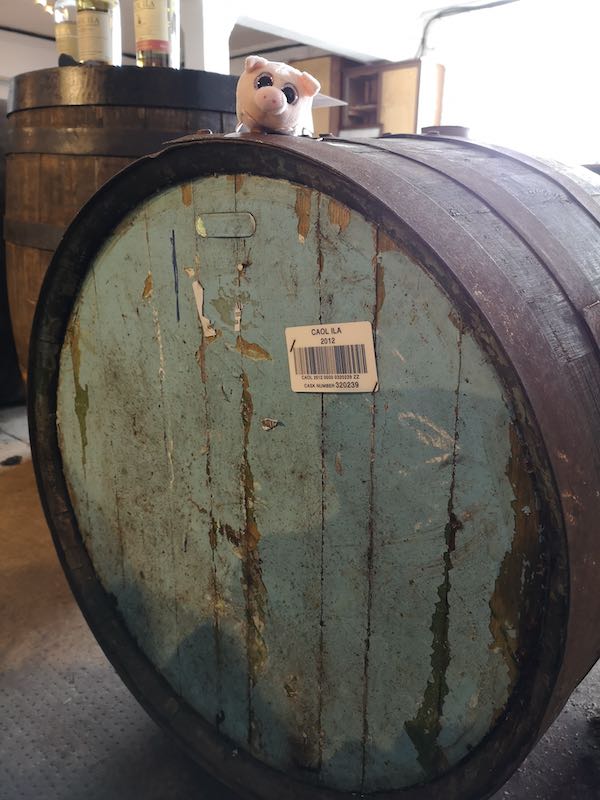
2012 Caol Ila Cask,
It was a treat like no other! We enjoyed the large pours from our guide, chit-chat about whisky in general, and made new friends from the Netherlands! We also met the couple whom we saw at Ardnahoe, which was really a pleasant surprise! After all the drams, our guide also encouraged us to walk around the room, looking at some of the artefacts that the distillery collected over the years.
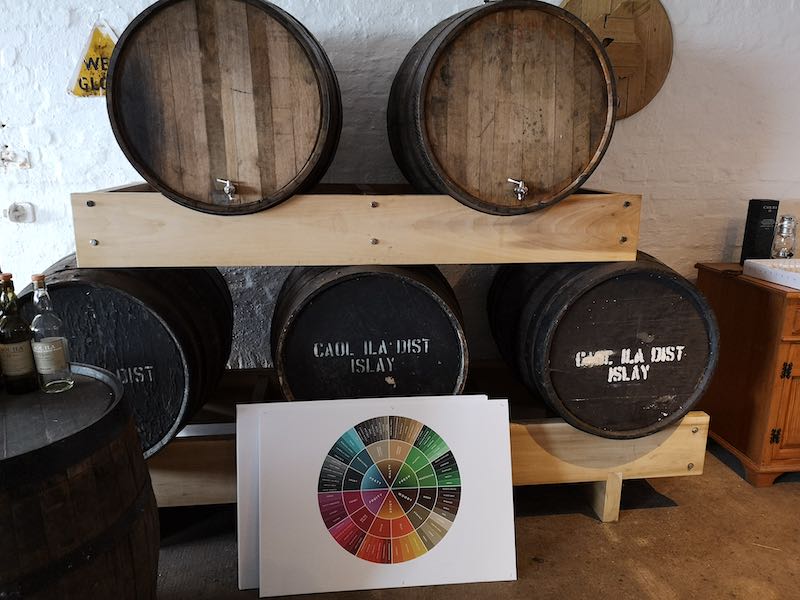
Used Barrels and a Colour Chart
We noticed some interesting old bottles of Caol Ila lying around too. Check them out!
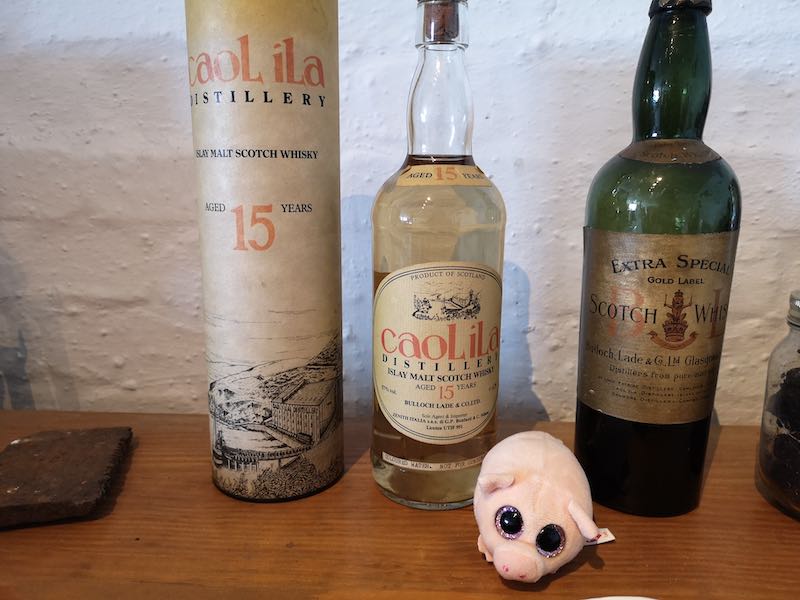
Curly was really excited too!
Unfortunately, we needed to clear the room for the next tour before we could ask more about these bottles. Nevertheless, it was really enjoyable despite the disappointment of not being able to visit the mash tuns and the washbacks.
Return to reality
Exiting the Tasting Room carrying our drams, we went back to the shop just to meet yet another group of disappointed visitors who did not pre-book their tours. This group was unhappy when they saw us coming back, and some heated arguments started between the unhappy group and the team at the shop. Thankfully, our guide arrived in time, and she stopped the commotion.
As for us, we quickly side-stepped the incident by moving deeper into the shop to look at the bottles available.
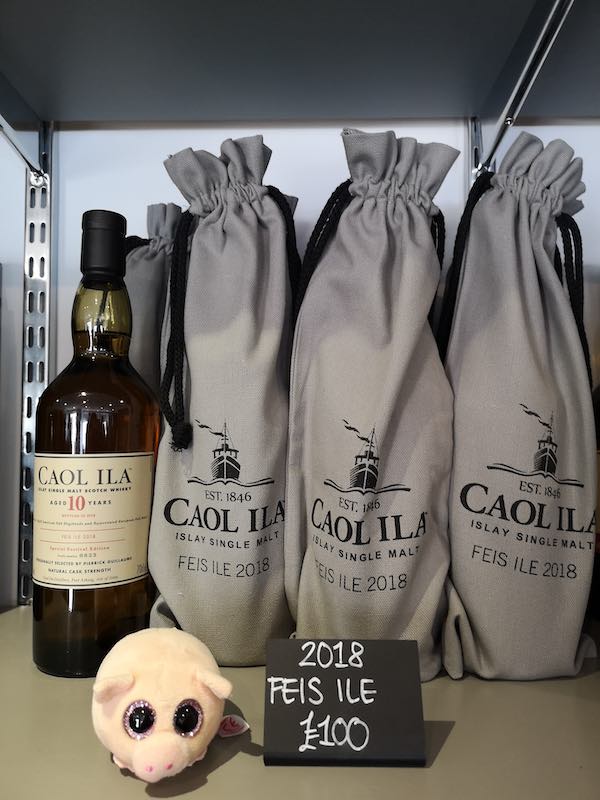
Feis Ile 2019
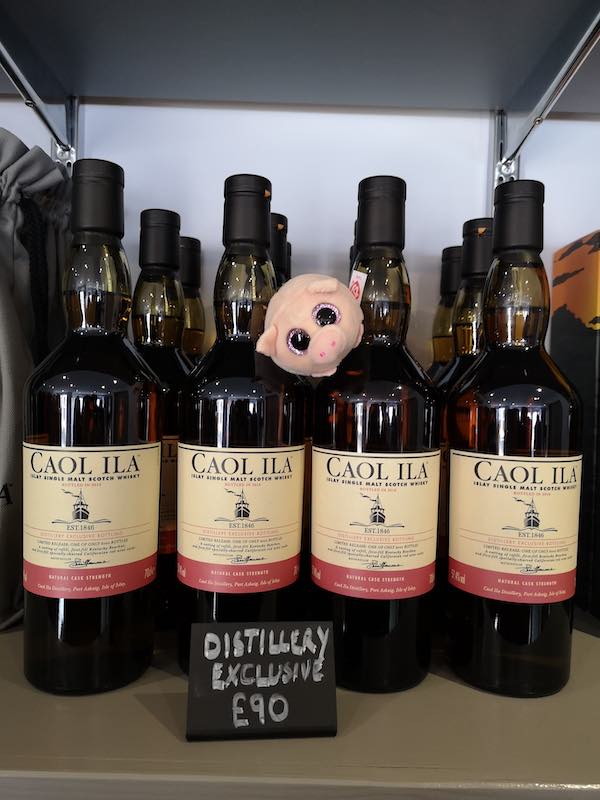
Distillery Exclusive
It was disappointing that these were the best bottles on offer at the distillery, and the rest were the core range. As we had already tried the two expressions during the tour, we did not buy them home. All we did was to buy a super nice Caol Ila Down Jacket instead!
Our travels on Islay is over, folks! Caol Ila was the last distillery that we visited so we will be starting other articles from next week. Our team did visit Bruichladdich for a tour, but because we wrote a lot of articles on Bruichladdich previously, we decided to omit the tour unless our readers request for it!
We did not go on tours at Bowmore, Lagavulin and Bunnahabhain because we couldn’t make time for it. However, we visited their shops and bars to purchase bottles and drinks! This omission also meant that we have another excuse to go back to Islay in future!
WhiskyGeeks hopes that you had a lot of fun touring Islay with us! Stay with us, though! There will be more interesting articles coming up. 😀
11311 Harry Hines Blvd
Dallas, TX, United States
(555) 389 976
dallas@enfold-restaurant.com
